Minimalist living is about simplifying your life by reducing clutter and focusing on what truly matters. It encourages a more intentional approach to our belongings and daily routines, allowing for greater peace of mind and freedom. By embracing this lifestyle, you can create a more serene space and a clearer mindset, making room for experiences that bring joy rather than just accumulating things.
Embracing the Less: Understanding Minimalist Philosophy
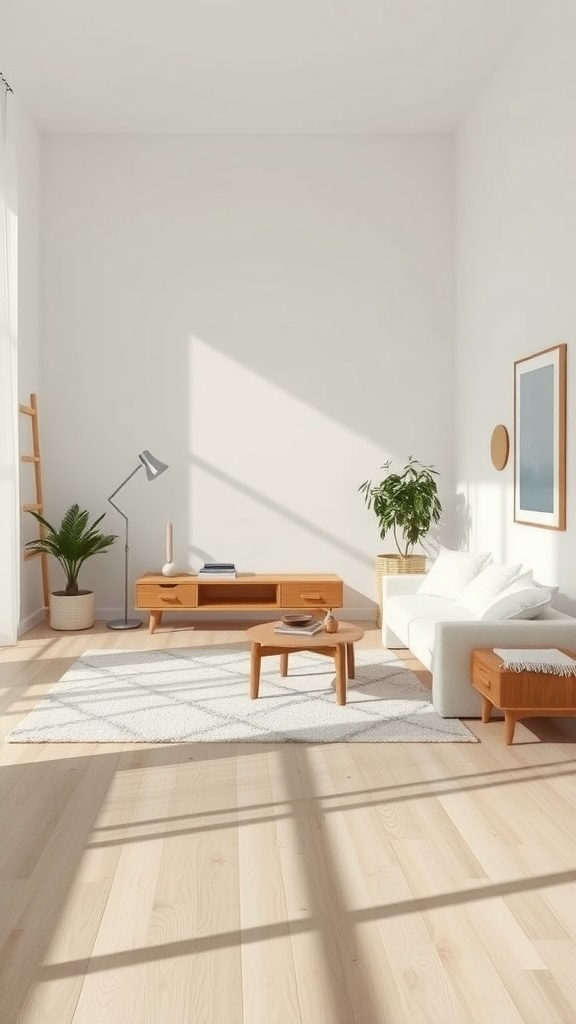
In a world filled with clutter, minimalist living shines as a refreshing approach. The image captures a serene space that embodies this philosophy perfectly. The soft, natural light streaming through the windows emphasizes simplicity and tranquility.
The cozy seating area invites relaxation, with a clean, white sofa and warm wooden furniture. A small plant adds a touch of life, reminding us of nature’s beauty. The overall design is functional yet stylish, showcasing how less can indeed be more.
Each piece in this room serves a purpose, aligning with the core values of minimalism. This philosophy encourages us to reflect on what we truly need and to let go of excess. The result? A more peaceful and fulfilling lifestyle.
Essentialism vs. Minimalism: Key Differences
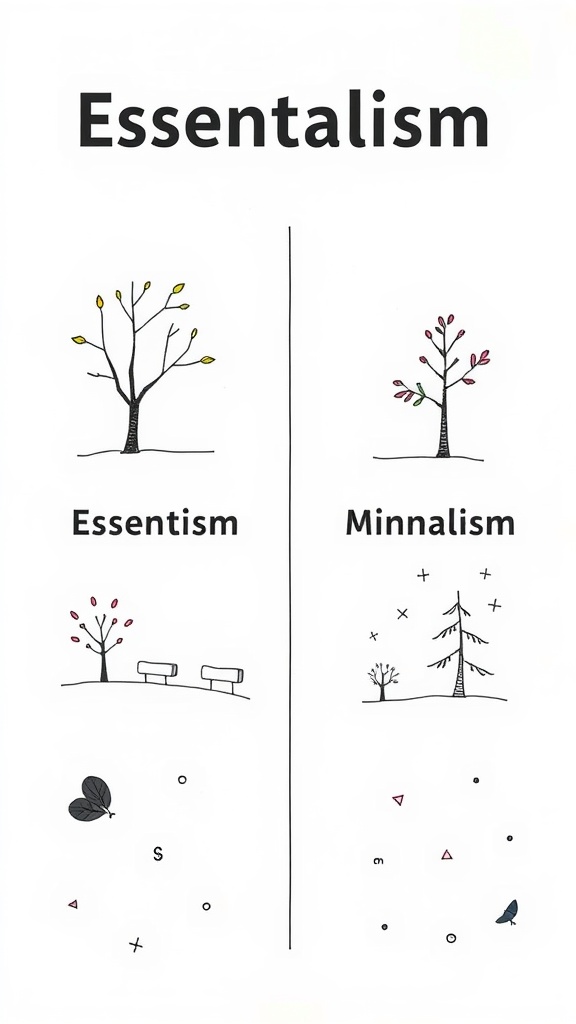
When exploring minimalist living, it’s essential to understand the difference between essentialism and minimalism. The image shows two distinct trees, one for each concept, highlighting their unique characteristics.
On the left, we see essentialism. This tree has a few leaves, suggesting that it values quality over quantity. It represents the idea of focusing on what truly matters in life. Alongside are benches, symbolizing rest and connection to nature. This approach emphasizes thoughtful choices, allowing individuals to prioritize their most important goals and values.
On the right, minimalism features a more stripped-back tree with fewer details. This style embraces simplicity by reducing distractions. The open space around it reinforces the notion that less is more. Minimalism encourages decluttering both physically and mentally, creating a serene environment.
Understanding these differences can help you choose the lifestyle that resonates with you. Whether you lean toward essentialism or minimalism, both paths can lead to a more fulfilling life.
Creating a Capsule Wardrobe: Fashion Minimalism
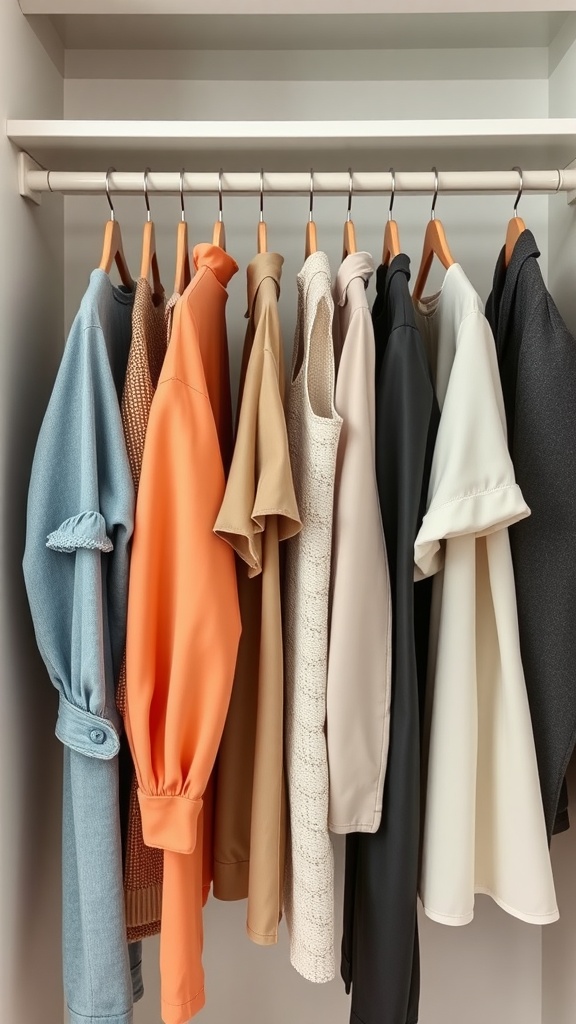
When it comes to minimalist living, a capsule wardrobe is a fantastic way to simplify your fashion choices. The image showcases a neatly organized closet with a selection of stylish tops hanging in soft colors. Each piece stands out yet blends harmoniously with the others, making it easy to mix and match.
This approach helps reduce decision fatigue. You can grab a top and feel confident it will pair well with multiple bottoms. Think about how freeing it is to open your closet and see only what you love.
A capsule wardrobe is not just about quantity, but quality too. Invest in items that feel great and look good on you. Look for versatile pieces that can transition from day to night. The right colors and styles can create endless outfit possibilities.
As you curate your clothing, consider your lifestyle and personal style. Select pieces that make you feel happy and comfortable. Remember, minimalism is about making space for what truly matters to you.
The Benefits of Minimalist Living on Mental Health
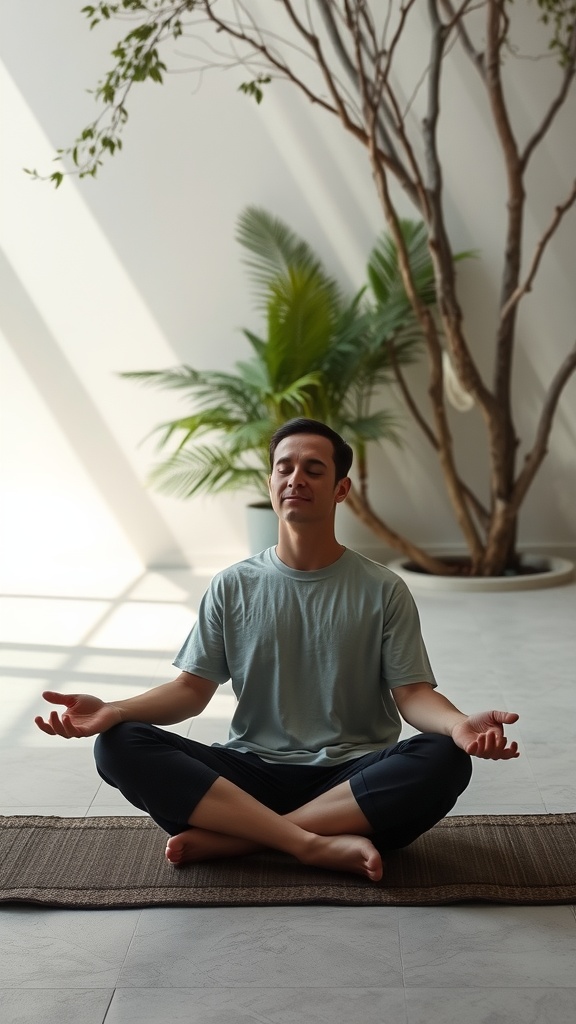
Minimalist living creates an environment that promotes peace and clarity. In the image, we see a person sitting calmly in a serene space, surrounded by greenery. The simplicity of the setting reflects how a clutter-free space can ease the mind.
When you embrace minimalism, you often find a reduction in stress and anxiety. Fewer possessions mean less to manage and worry about. The person in the image, practicing mindfulness, captures the essence of focusing on what truly matters. This practice can lead to better mental clarity and emotional balance.
Moreover, minimalist living encourages intentionality. By surrounding yourself with fewer distractions, you can prioritize your mental health and well-being. The peaceful setting in the image illustrates how a mindful space can help you reconnect with yourself.
Overall, minimalism can be a game changer for mental health. It creates space for relaxation and self-reflection. The calm demeanor of the individual in the image highlights the benefits of slowing down and simplifying life.
Mindful Consumption: Reducing Material Dependencies
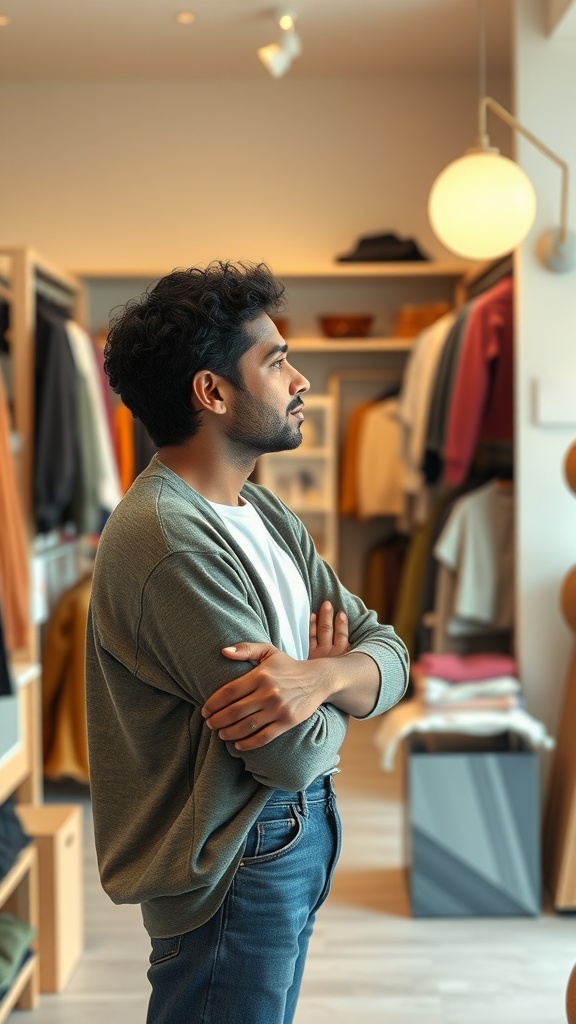
In a world filled with choices, standing in a shop can feel overwhelming. The image captures a moment where someone is thoughtfully considering their options. Surrounded by shelves lined with books and products, it illustrates the essence of mindful consumption.
This scene encourages us to pause before making a purchase. Instead of grabbing items on impulse, we can reflect on what we truly need. By evaluating our desires, we can reduce clutter and focus on quality over quantity.
Minimalist living is about simplifying our lives. It’s not just about the number of items we own, but the impact those items have on our well-being. By being selective in what we consume, we create space for experiences and connections that matter more.
So, the next time you find yourself in a store, take a moment to think. Are those items adding value to your life? Embracing this practice can lead to a more fulfilling, mindful way of living.
Designing a Minimalist Home: Aesthetic Choices
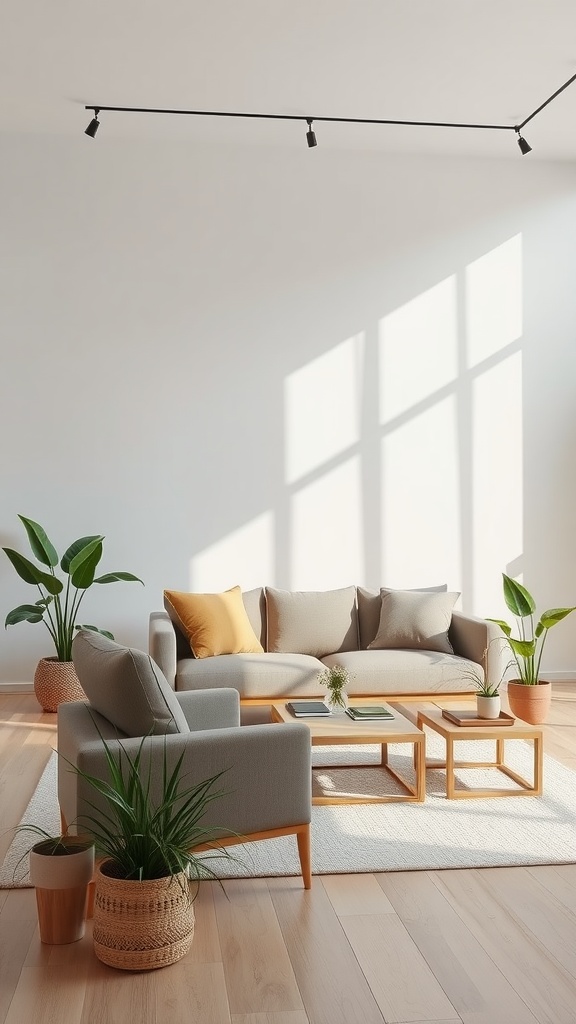
Creating a minimalist home starts with making smart aesthetic choices. In the image, you can see a bright and open living space that perfectly captures the essence of minimalism.
The light color palette of the walls and furniture creates a serene atmosphere. The choice of a simple gray sofa and armchairs allows the room to feel spacious and uncluttered. A pop of color from the orange pillow adds a touch of warmth without overwhelming the space.
The wooden furniture pieces, including the coffee table, are functional yet stylish. They provide a natural element that complements the overall feel of the room. The presence of plants brings life into the space, enhancing its freshness and connection to nature.
The use of natural light is another key feature here. Large windows allow sunlight to pour in, brightening the room and creating inviting shadows. This feature highlights how important it is to consider light when designing a minimalist home.
Overall, this image illustrates that minimalist design is not just about reducing clutter; it’s about making thoughtful choices that foster a peaceful environment.
The Role of Nature in Minimalist Living Spaces
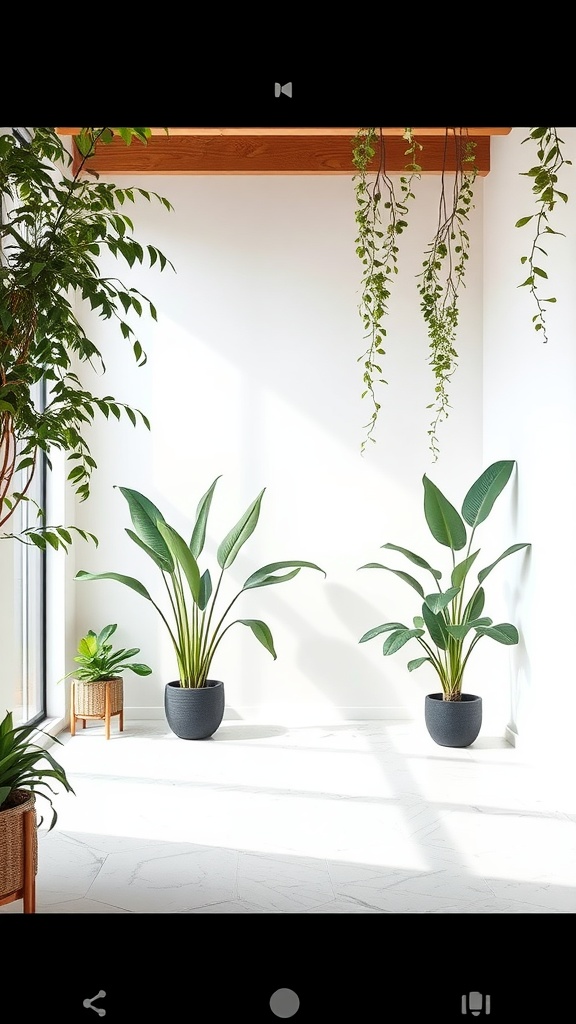
Nature brings a refreshing vibe to minimalist living spaces. The image shows a bright, airy room with lush green plants, which instantly draws the eye. The simplicity of the decor lets the natural elements shine.
Having plants around not only enhances the aesthetic but also provides a sense of calm. The clean lines and open space allow everyone to feel relaxed and connected to nature. The plants are thoughtfully placed, creating balance without overwhelming the area.
Incorporating greenery promotes a healthier atmosphere. Plants can improve air quality and bring a little life into a more simple environment. This blend of minimalism and nature creates a peaceful retreat that invites mindfulness into daily living.
Digital Minimalism: Streamlining Your Online Life
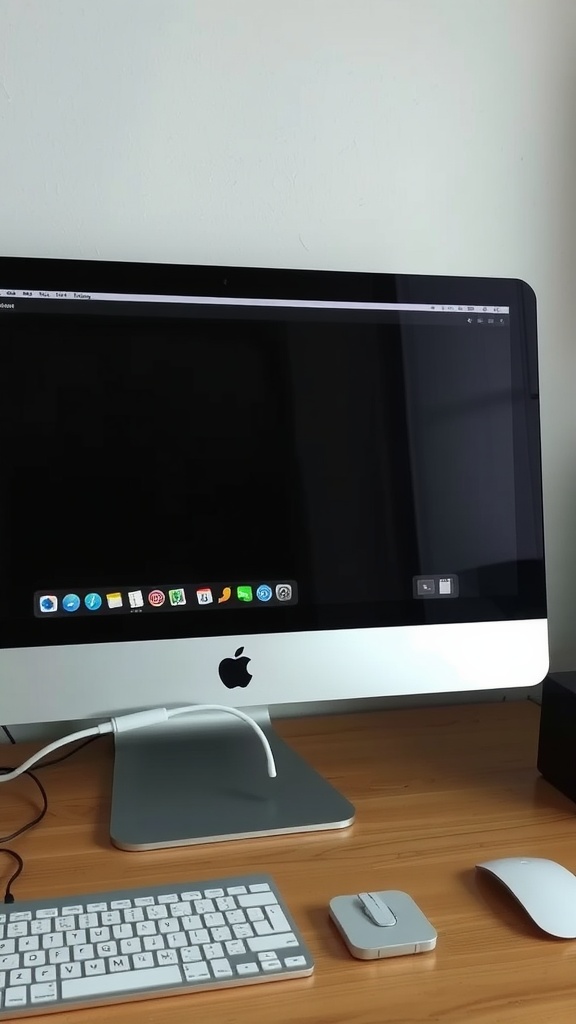
The image perfectly captures the essence of digital minimalism. A sleek computer setup with a clean desk reflects a focus on simplicity. The screen is mostly empty, inviting you to think about what’s truly important in your online space.
Digital minimalism is about clearing the clutter from your digital life. It encourages you to evaluate what apps and websites you really need. Are you spending time on social media that doesn’t enrich your life? It might be time to cut back.
Having a neat workspace, like the one in the image, can help you focus better. It’s easier to concentrate when distractions are minimized. Consider paring down your digital devices too. Do you really need all those gadgets?
Streamlining your online life means saying no to endless notifications and yes to meaningful interactions. It’s not just about less screen time; it’s about making your screen time count. Choose quality over quantity when it comes to content and connections.
Sustainable Minimalism: Eco-Friendly Choices
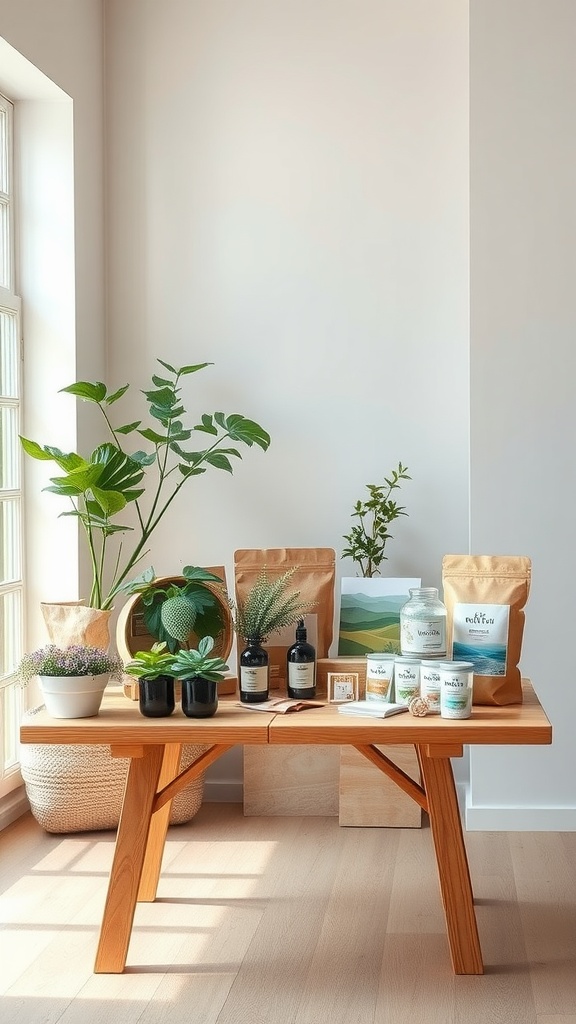
In the image, we see a bright and airy space that embodies the essence of minimalist living. A wooden table serves as a focal point, adorned with eco-friendly products and lush plants. This setup not only looks inviting but also reflects a thoughtful approach to sustainability.
The plants add life and freshness, reminding us that nature can play a significant role in our homes. They also help improve air quality, making our living spaces healthier. Each product on the table is carefully chosen, showcasing a commitment to eco-friendly living.
Way beyond aesthetics, sustainable minimalism encourages us to select items that are good for the planet. Fewer, high-quality products can lead to less waste. Choosing natural ingredients and sustainable packaging shows that conscious decisions matter.
Minimalism teaches us that our choices can impact the environment. By supporting brands that prioritize sustainability, we feel good about what we bring into our homes. Simple changes, like opting for refillable containers or biodegradable materials, can make a world of difference.
Adopting a Minimalist Lifestyle: Habits to Develop
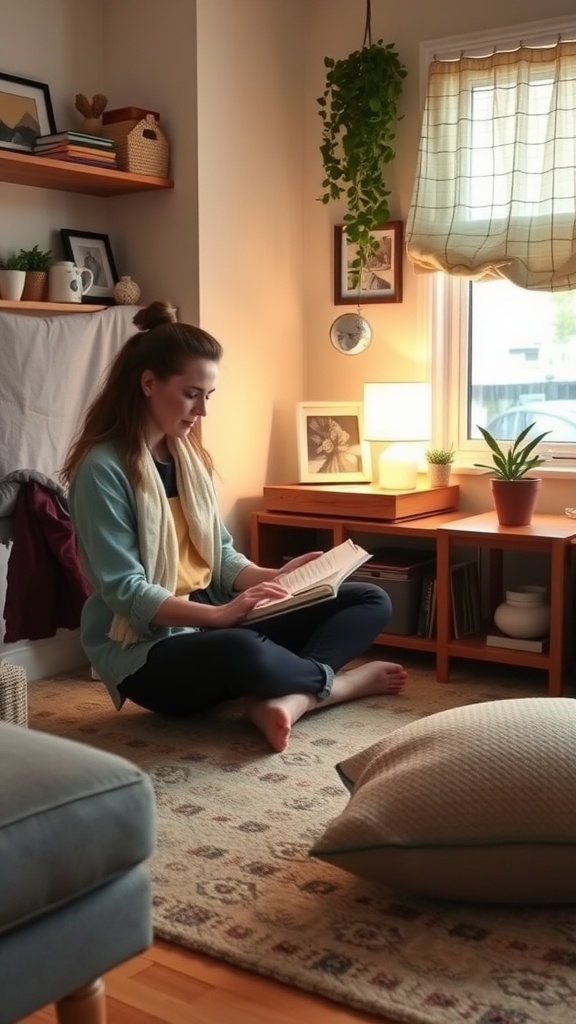
In this image, we see a person relaxing in a simple, uncluttered living space. The cozy chair, soft rug, and a few potted plants create a peaceful environment. This reflects the essence of minimalist living, focusing on what truly matters and eliminating excess.
One of the first habits to develop is decluttering. Go through your belongings and keep only what you truly need or love. This not only clears physical space but also helps clear your mind.
Another habit is to create a designated reading nook, like the one shown in the image. It’s inviting and encourages quiet time. Reading not only enriches your mind but also offers a break from the daily hustle.
Embrace simplicity in your decor. Choose functional yet stylish furniture pieces. The bookshelves in the background provide storage while adding character without overwhelming the space.
Incorporating greenery can also enhance your minimalist lifestyle. Plants bring life into your home and improve air quality, making your space feel fresh and inviting.
Lastly, practice mindfulness. Spend a few moments each day reflecting on what you appreciate in your life. This habit will help reinforce the values of minimalism.
Minimalist Cooking: Simple Recipes with Few Ingredients
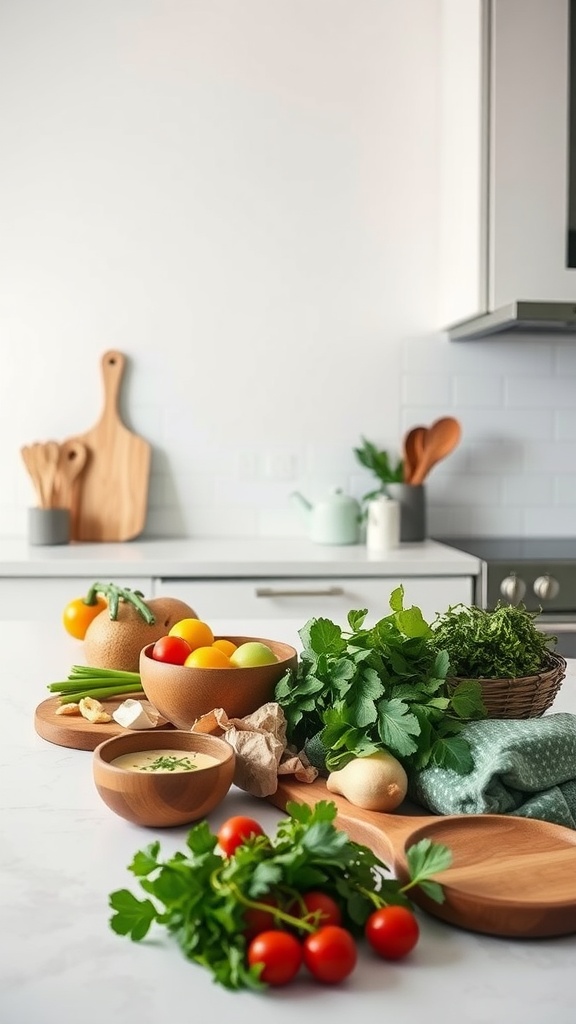
Minimalist cooking is all about simplicity. The image showcases a clean kitchen counter filled with fresh ingredients. You see vibrant tomatoes, green herbs, and colorful fruits, all waiting to be turned into something delicious.
With just a few items, you can whip up tasty meals without the clutter. This approach not only saves time but also reduces stress in the kitchen. You don’t need an extensive pantry to enjoy good food; fresh produce is often enough.
Think about a simple salad. Toss together cherry tomatoes and chopped parsley with a drizzle of olive oil. Season with salt and pepper. Voila! A fresh dish in minutes. Or consider a soup: blend some vegetables, add broth, and heat. Easy, right?
The key is to focus on quality ingredients. Each item in this image, whether it’s the herbs or the fruits, adds its own flavor. So, embrace the minimalist approach and enjoy cooking with less!
Decluttering Your Space: The First Step to Minimalism
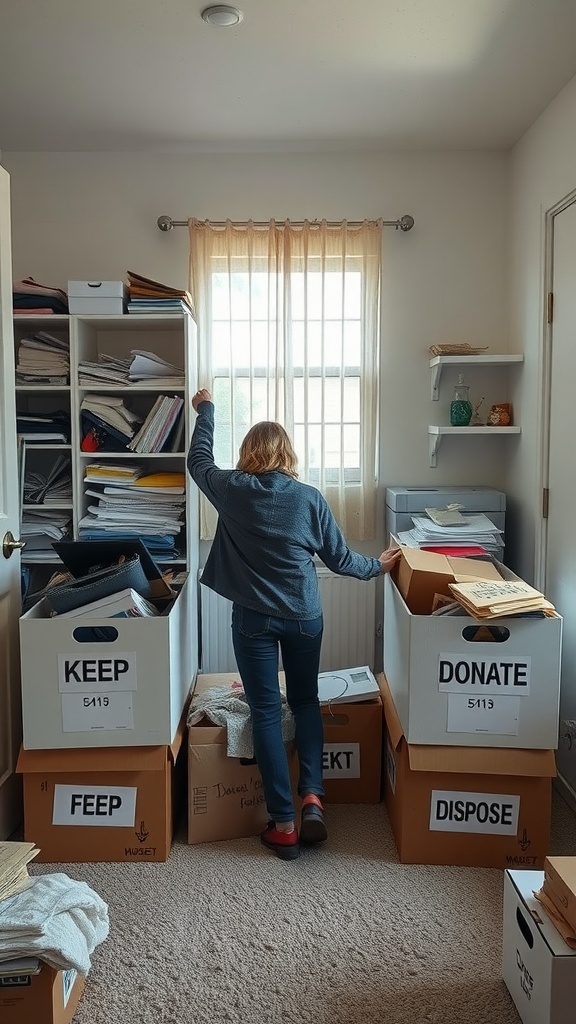
In the photo, we see someone taking a moment to assess their belongings. Surrounded by boxes labeled ‘KEEP’, ‘DONATE’, ‘DISPOSE’, and ‘FEEP’, it’s clear they are in the process of decluttering. This moment captures the essence of starting a minimalist lifestyle.
Decluttering is more than just tidying up; it sets the foundation for minimalism. Each box represents a decision-making process. The ‘KEEP’ box holds items that serve a purpose or bring joy, while the ‘DONATE’ and ‘DISPOSE’ boxes help in letting go of things that no longer fit your life.
As you declutter, consider what you truly need. This can be freeing and help create a more open space. It also encourages a fresh perspective on what you value. A lighter space often leads to a lighter mind, paving the way for a more minimalist lifestyle.
Minimalism and Travel: Packing Light for Adventures

Traveling can be a freeing experience, especially when you embrace minimalism. In the image, we see a simple brown backpack. It’s packed with essentials that make traveling easy and enjoyable. The backpack features a few vibrant items peeking out, showing that you don’t need to carry much to have a good time.
When packing light, focus on what’s necessary. A sturdy backpack like this one can hold your gear without weighing you down. You might notice a reusable water bottle, a portable charger, and maybe some snacks. These items keep you energized and connected without the clutter of excess baggage.
Minimalism encourages you to select only what adds value to your trip. Think of items that serve multiple purposes or are lightweight. This way, you can fully enjoy your surroundings without worrying about heavy bags or forgotten items.
As you plan your travels, take a cue from this image. The beauty of a minimalist approach is not just in packing light but in allowing yourself to experience more. Less stuff means more space for memories and moments that matter.
Building Connections: Minimalist Relationships
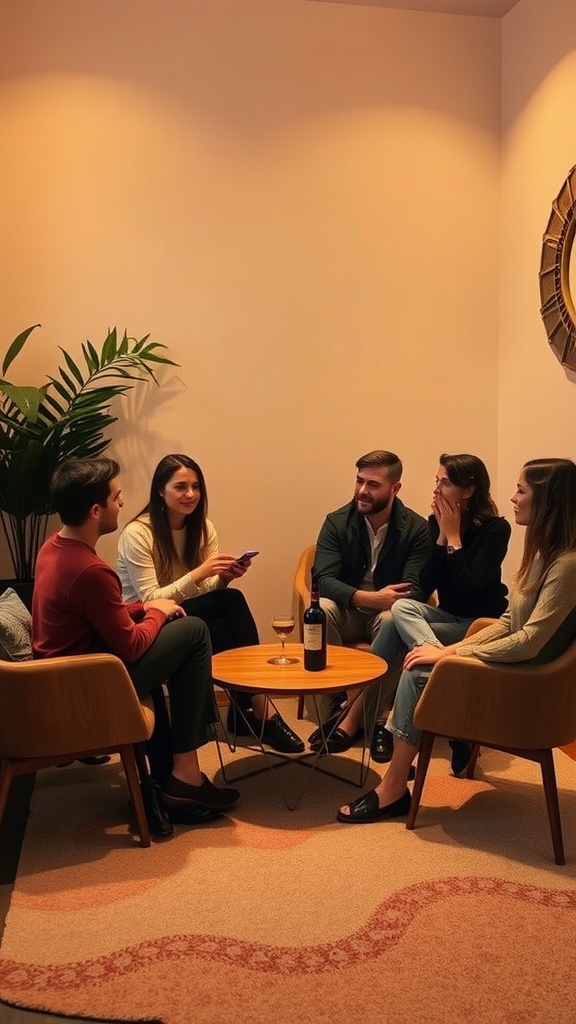
In a world filled with distractions, minimalist living encourages us to focus on what truly matters: our relationships. The image captures a cozy gathering of friends, enjoying each other’s company. With a simple setting of comfortable chairs and a small table, the scene shows how minimalism can create an inviting space for connection.
Each person seems engaged, sharing stories and laughter. This kind of interaction is what minimalist relationships are all about. It’s not the grand settings or lavish events that create bonds, but the genuine moments spent together.
The presence of a bottle of wine adds a warm touch, inviting conversation and making the gathering feel special. The relaxed vibe of the room highlights that meaningful connections often thrive in simple environments.
Minimalism teaches us to appreciate quality over quantity. Instead of spreading ourselves thin across numerous acquaintances, we find value in nurturing a few close friendships. This approach allows for deeper connections that enrich our lives.
Ultimately, it’s about being present, listening, and supporting each other in a clutter-free space. Whether it’s a small get-together or a quiet dinner, the essence of minimalist relationships lies in creating meaningful interactions.
Challenges of Minimalist Living: Overcoming Obstacles

Minimalist living is an appealing concept, but it comes with its own set of challenges. The image of a person standing in front of a chaotic pile of papers and belongings perfectly captures this struggle. It’s easy to be overwhelmed when trying to simplify life, especially if clutter has built up over time.
One main challenge is the emotional attachment to items. Many people find it hard to let go of possessions that hold memories or seem useful. This can lead to indecision and frustration. It’s important to approach decluttering with a clear plan, focusing on what truly adds value to your life.
Another obstacle is the misconception that minimalism means eliminating everything. People may feel pressured to get rid of their favorite things. It’s vital to remember that minimalism is about making choices that align with your values and lifestyle. Finding balance is key.
Lastly, the shift towards minimalism can feel isolating. Friends or family members may not understand the desire to simplify. Building a support system, possibly through online communities, can provide encouragement and inspiration.
